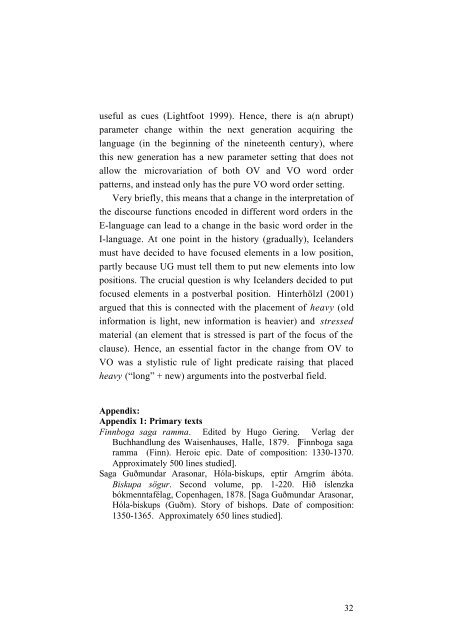Explaining language change: A three step process
Explaining language change: A three step process
Explaining language change: A three step process
You also want an ePaper? Increase the reach of your titles
YUMPU automatically turns print PDFs into web optimized ePapers that Google loves.
useful as cues (Lightfoot 1999). Hence, there is a(n abrupt)<br />
parameter <strong>change</strong> within the next generation acquiring the<br />
<strong>language</strong> (in the beginning of the nineteenth century), where<br />
this new generation has a new parameter setting that does not<br />
allow the microvariation of both OV and VO word order<br />
patterns, and instead only has the pure VO word order setting.<br />
Very briefly, this means that a <strong>change</strong> in the interpretation of<br />
the discourse functions encoded in different word orders in the<br />
E-<strong>language</strong> can lead to a <strong>change</strong> in the basic word order in the<br />
I-<strong>language</strong>. At one point in the history (gradually), Icelanders<br />
must have decided to have focused elements in a low position,<br />
partly because UG must tell them to put new elements into low<br />
positions. The crucial question is why Icelanders decided to put<br />
focused elements in a postverbal position. Hinterhölzl (2001)<br />
argued that this is connected with the placement of heavy (old<br />
information is light, new information is heavier) and stressed<br />
material (an element that is stressed is part of the focus of the<br />
clause). Hence, an essential factor in the <strong>change</strong> from OV to<br />
VO was a stylistic rule of light predicate raising that placed<br />
heavy (“long” + new) arguments into the postverbal field.<br />
Appendix:<br />
Appendix 1: Primary texts<br />
Finnboga saga ramma. Edited by Hugo Gering. Verlag der<br />
Buchhandlung des Waisenhauses, Halle, 1879. [Finnboga saga<br />
ramma (Finn). Heroic epic. Date of composition: 1330-1370.<br />
Approximately 500 lines studied].<br />
Saga Guðmundar Arasonar, Hóla-biskups, eptir Arngrím ábóta.<br />
Biskupa sögur. Second volume, pp. 1-220. Hið íslenzka<br />
bókmenntafélag, Copenhagen, 1878. [Saga Guðmundar Arasonar,<br />
Hóla-biskups (Guðm). Story of bishops. Date of composition:<br />
1350-1365. Approximately 650 lines studied].<br />
32

















